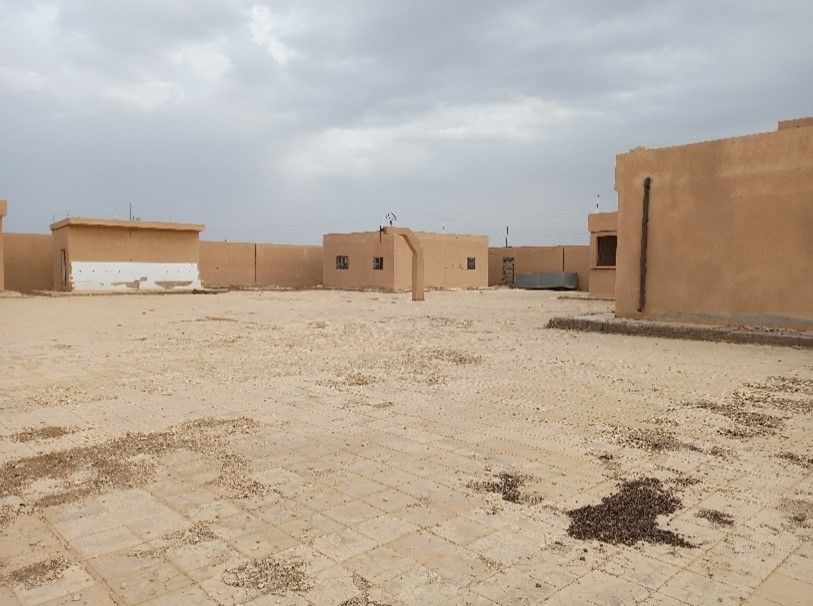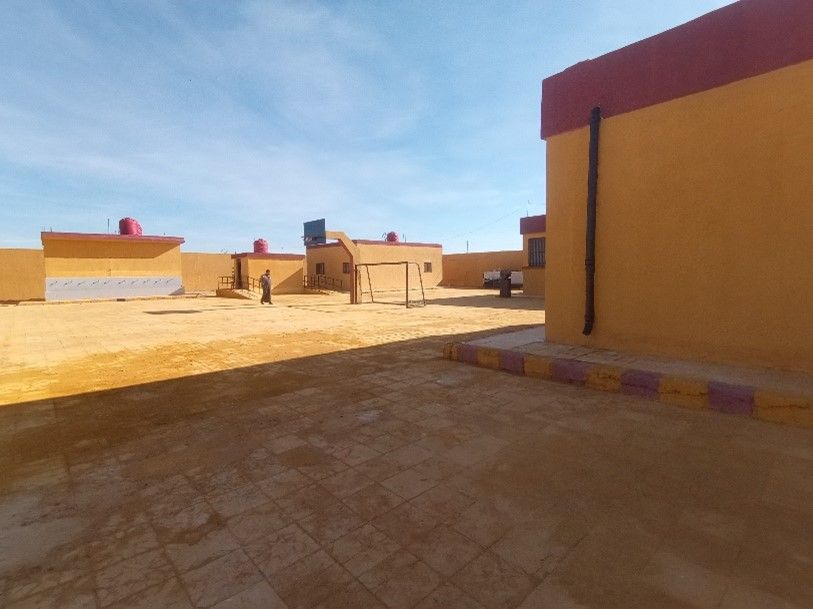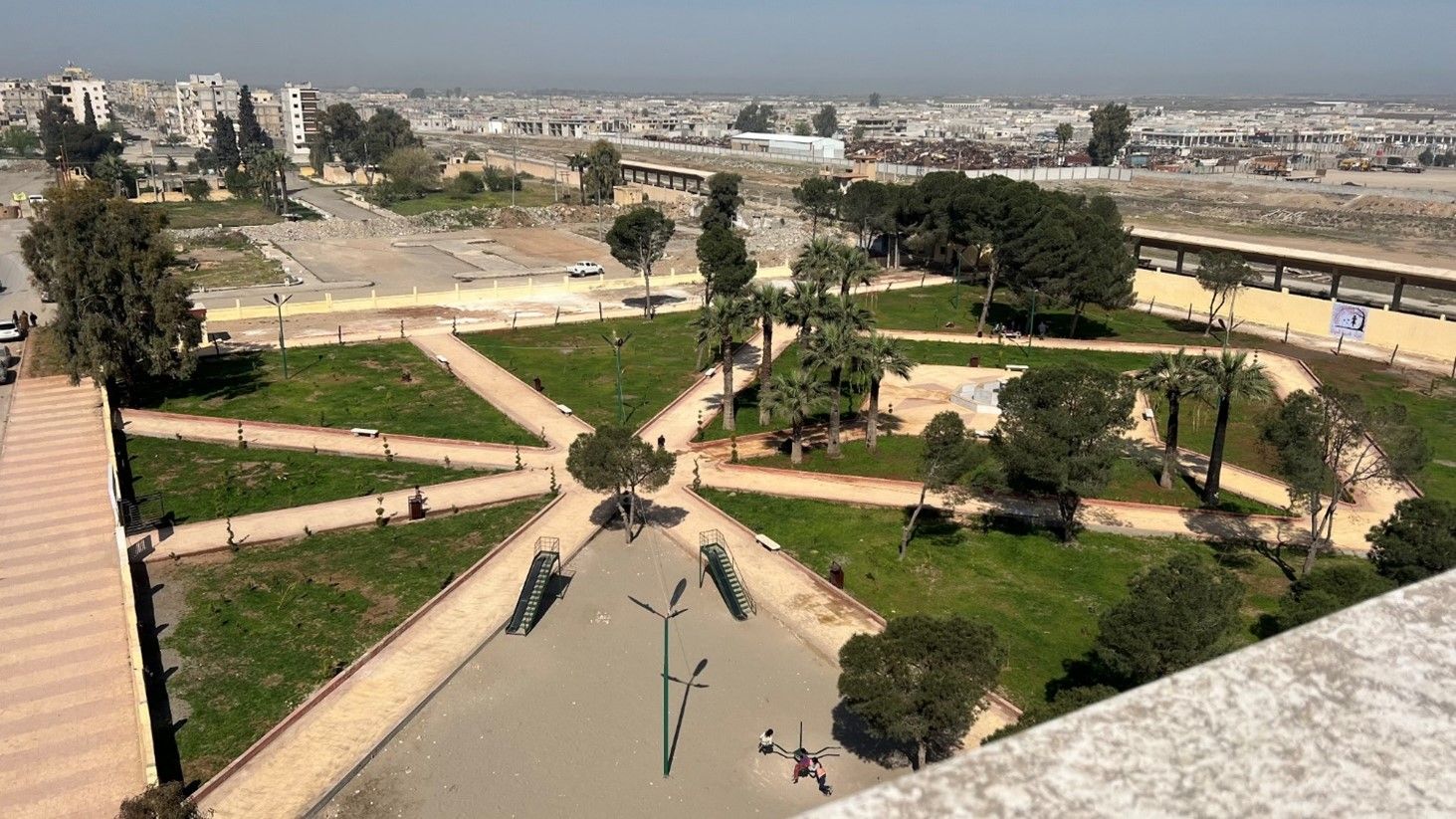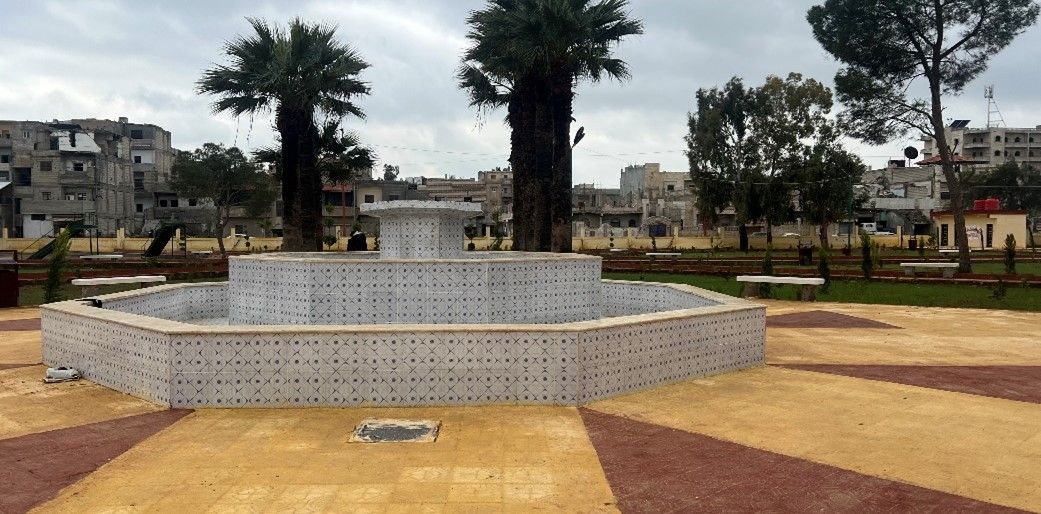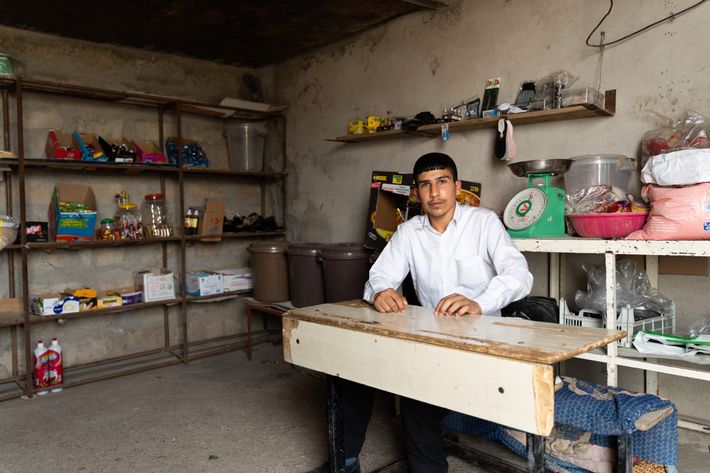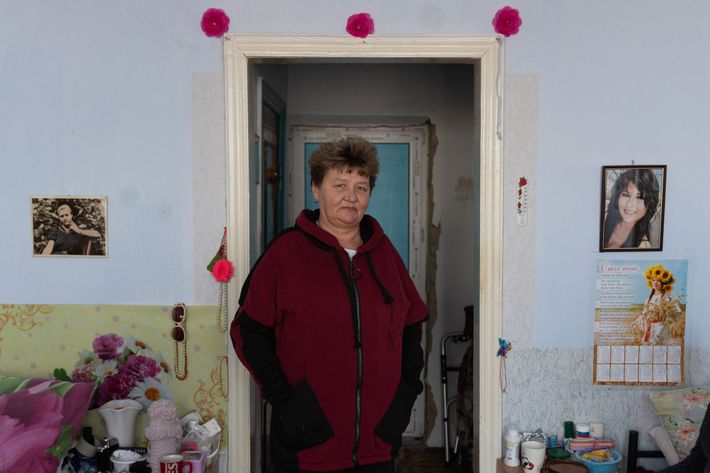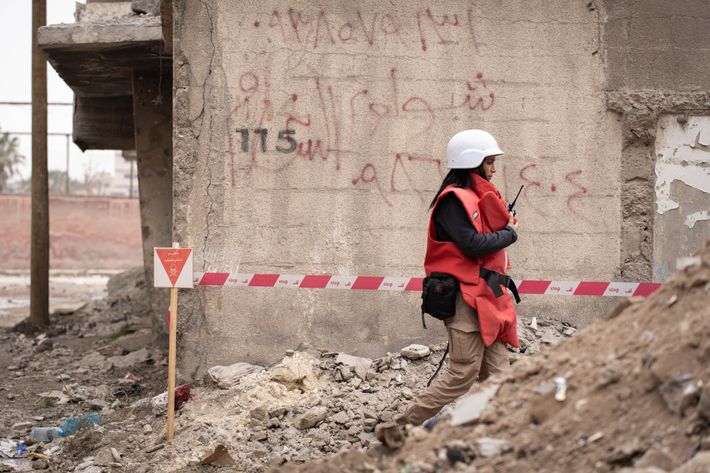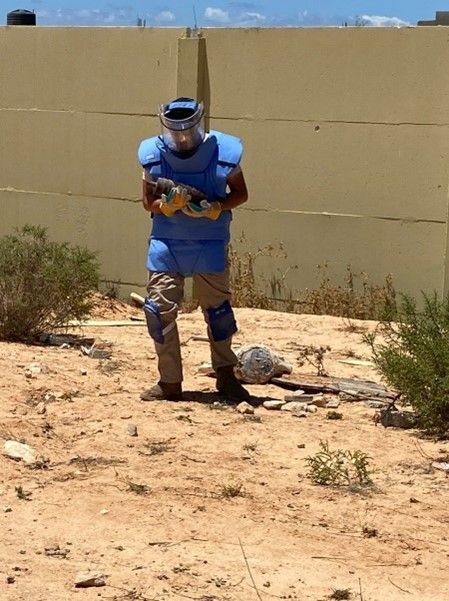International Mine Awareness Day 2025
4 April is the UN’s International Day for Mine Awareness and Assistance in Mine Action. In 2025, the theme “Safe Futures Start Here” highlights both the progress made in mine action and the urgent need to address the ongoing impact of explosive remnants of war—especially through inclusive solutions that empower persons with disabilities.

When the war in Kosovo ended in 1999 peace descended on one of the most landmine contaminated areas in the world. This is where DanChurchAid first started direct mine clearance to ensure that refugees and internally displaced people could return home.
Since then, clearing landmines and unexploded ammunition has become a central part of DanChurchAid’s humanitarian work, and today we are one of the world’s leading organisations in the clearance of landmines, cluster bombs, and other types of unexploded ammunition.
Read how it all started: Deminers clear a path
Facts about landmines
Every day, around 20 people are killed or injured after stepping on a landmine or setting off unexploded ammunition. Landmines are indiscriminate – they kill or injure anyone who steps on them. Be it a soldier, a farmer, or a schoolgirl. 80% of those killed or injured are civilians, and 25% are children.
But the injury sustained when you step on a mine is just one in a series of negative impacts.
Because mines also:
- make it difficult to lift yourself out of poverty
- make rebuilding local communities difficult and hamper development efforts
- make farming impossible and lead to food shortage
- keep children from moving freely and can stop them from going to school
- maintain an atmosphere of fear that is strangling to personal and collective initiative
Casualties in 2023

Who is at risk?
People who are displaced in their own countries, and returning refugees, are at particular risk of getting killed or injured by landmines or unexploded ammunition. Both groups of people are unfamiliar with the new hazards and underestimate the danger that landmines or unexploded bombs pose in areas that have experienced active battle or that have been of strategic military importance.
Removing landmines clears a path to hope
Our deminers work in the forests of rural DR Congo, in town centers of Syria, and in the suburbs of Kyiv. When we locate and remove landmines and explosives, we also remove obstacles that keep communities from farming the land, keep children from going to school, and hamper much needed development.
When we help release land that was contaminated by explosives, we save lives and spare people injury and suffering – but we also help build livelihoods and communities when farming, livestock grazing, and other activities can resume and grow.
Three mine clearers in three countries:

Rima in Lebanon:
“I have two family members who were killed when they were about 12 years old. When I grew up, I decided that I wanted to make a difference for my children – and for all children in Lebanon.”

Nour in Syria:
“We have found and removed thousands of explosives. As long as there are landmines in the ground, we have work to do.”

Anna in Ukraine:
“As a team leader, I must look after my team. Every morning, I gather them, ask everyone how the night has been, and ensure that everyone is focused on today’s work.”
Farmers hoping to reap only what they sow
A lack of jobs and an income can also force some people into areas that are not safe. Farmland is often in high demand – and the poorest might see no other option than farming in areas where there could still be unexploded ammunition and mines in the ground. But often such fertile areas lie unused when they could be used for farming and sustenance for people in surrounding communities.
Moreover, the fear of a potentially lethal threat that is virtually invisible to the naked eye, creates a feeling of uncertainty that remains in communities long after conflicts have ended.
It is a fear that takes away initiative, slows peace processes, and stunts development for years.
”Clearing landmines and unexploded ammunition is a prerequisite for the safe return of refugees – for them to return to life as they know it after a war. Peace is not just the absence of fighting – it is also being able to move around freely without the fear of stepping on a landmine or bomb.”Jonas Nøddekær, Secretary General, DanChurchAid

How we work
DanChurchAid works with demining in several ways – including:
- training deminers and offering international clearing courses
- creating awareness in local communities where landmines and unexploded ammunition are present to avoid accidents
- training people in areas where there are mines and explosives to identify and report threats
- offering assistance to victims of landmines or unexploded ammunition
- engaging in activities aimed at deescalating or avoiding armed conflict
Did you know?
Landmines can be produced for between $3 and $75 US Dollars – removing one costs between $300 and $1,000 US Dollars.

Did you know?
Mine Action is about removing landmines and explosives – but it is more than that. It is a term that collectively describes all the activities carried out to reduce harm – social, economic, and environmental – related to identifying and removing explosives.
It rests on five pillars:
- clearance
- risk education
- victim assistance
- advocacy
- stockpile destruction
Where we work
Since 2008, DanChurchAid has cleared more than 200 km2 of land around the world. In 2025, we work in nine countries and areas – DR Congo, Ethiopia, Gaza, Lebanon, Libya, Mali, South Sudan, Syria, Ukraine – where we either build the capacity of partners to conduct mine clearance or work with our own clearance teams.
In some places mine clearance takes place where fighting has just happened – and may still break out – and in other places we remove decade-old landmines in a relatively peaceful context.
Often mine clearance is combined with other activities tailored to the local context – such as rehabilitating schools and other structure, offering psycho-social support to people traumatised by war, enabling productive use of the land that is made accessible after mine clearance, and more.
Read more: DCA’s Humanitarian Mine Action Around the World
Demining in the DR Congo
DanChurchAid is the last international NGO carrying out humanitarian mine action in the Democratic Republic of Congo. More than 400,000 m2 land – or 56 football pitches – in nine regions in Eastern DR Congo are to be cleared.
Video: Rasmus Kristiansen
Minimising risks in Ukraine
50 years to clear Ukraine

DanChurchAid’s demining experts in Ukraine estimate that 1/3 of Ukraine’s territory could be contaminated by landmines and explosive. Even if all of resources currently available for humanitarian mine action globally were put together, it would take 50 years to make Ukraine landmine impact free.
By 2025, Ukraine has one of the world’s highest concentrations of landmines and unexploded bombs and ammunition on its territory. Consequently, Ukraine also has one of the highest number of casualties caused by these explosives.
DanChurchAid opened its first office in Ukraine in 2022 – and by 2025 has two offices jointly with Norwegian Church Aid in Kyiv and Mykolaiv. DanChurchAid works to continuously build and adjust its program to meet the most relevant and desperate needs in Ukraine – with the ultimate goal of making it safe for returnees to resettle in Ukraine and help rebuild their country.
Shortly after Russia invaded Ukraine, DanChurchAid responded with emergency aid and built shelters for displaced families. This was quickly followed by the delivery of protective gear, such as aprons, helmets, detectors, radios, and GPS systems, to support local partners working to reduce the threat of landmines and unexploded ordnance.
In addition, we work with partners who provide training and information for people who are in contact with landmines and other remnants of war.
Local partnerships and training
DanChurchAid collaborates with local authorities and local organisations in training children to identify mines or other dangerous remnants of war, to report to an authority the finding of such objects, and knowing what areas to avoid by knowing how areas with explosives are or can be marked. In technical terms this is known as Explosive Ordnance Risk Education (EORE).
In Ukraine, we have conducted EORE for over 3,000 young people, children, and adults since August 2023. Classroom teaching consists of small interactive plays, signboards, board games, or songs to keep the student interested.



In South Sudan, DanChurchAid has also organized a talent show where schools can come together and show off their knowledge and skills. The show is funded by World Without Mines.
Read more about the talent show here: A Song for Safety
South Sudan: Young nation – old troubles
Gaining independence only in 2011 South Sudan may be the youngest nation in the world, not even a teenager yet, but its scars, trauma, and troubles are that of someone much older.
Decades of civil war and unrest have impacted its people, its infrastructure, and its economic and social development. The war prior to independence between what was Northern Sudan and Southern Sudan has left South Sudan of today with large areas contaminated with mines and unexploded bombs and ammunition. And unfortunately fighting continues to break out with no or little warning.
In 2022 the local UN Mission to South Sudan recorded three instances of fighting in South Sudan – the latest between August and September in the Upper Nile Region which displaced 20,000 people.
DanChurchAid works with a local partner, Support for Peace and Education Development Program (SPEDP), on educational activities directed at children and young adults.
The MineWolf
We also have demining activities that are carried out in tandem with activities aimed at helping the local population make the most of renewed access to land that was previously contaminated by landmines and explosives. The pairing of the two has been dubbed the ‘Hazard to Harvest’ approach – and it is especially relevant as South Sudan uses a Mini MineWolf machine. The MineWolf tills the soil in search for explosives – which also happens to be perfect preparation for planting crops.
Manual demining vs. MineWolf
Manual clearance:
10 deminers can clear around 20m2 each per day under ideal conditions. In total around 200m2 – and less on not-so-ideal days.
Mechanical clearance:
When the MineWolf smashes everything, and the deminers “just” follow-up with metal detectors, a team of 10 deminers can clear 2,500 m2 on average – or 10 times more.
Steps in the Demining Process
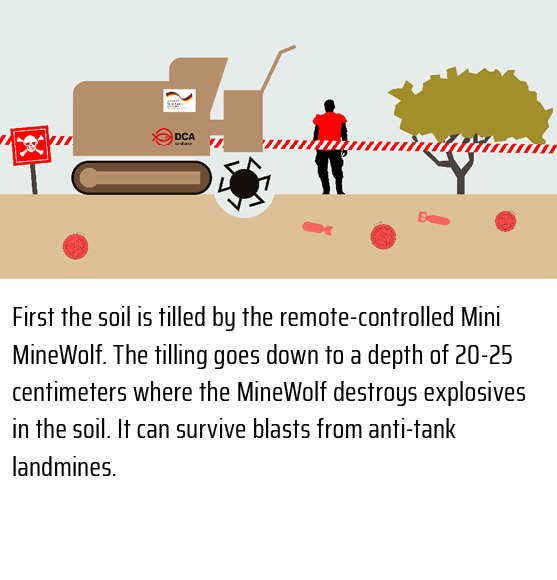

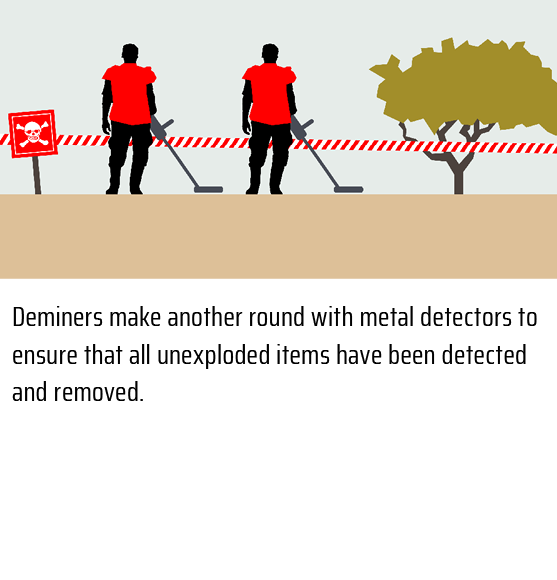
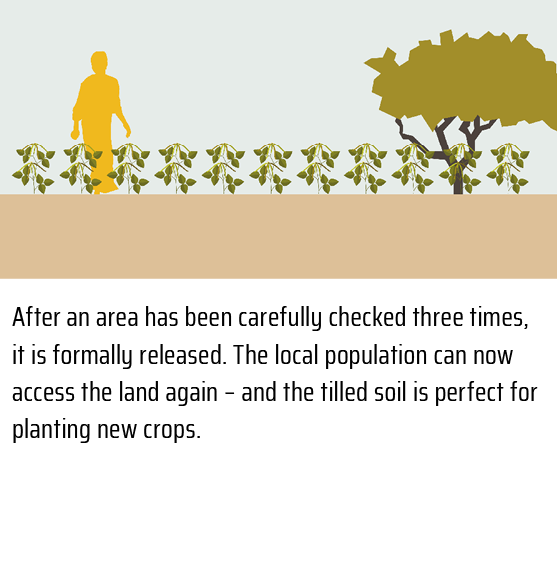
From Hazard to Harvest
In DR Congo, farming is a life-threatening task due to the threat of landmines. DanChurchAid is working to clear land contaminated by explosives step by step. Now more and more fields are becoming safe for communities to return, farm, and rebuild their lives.
Space for play and community in Ar-Raqqa, Syria
Since 2015, DanChurchAid has been working with mine and ammunition clearance in northeastern Syria. In many previously ISIS-controlled areas, there are still unexploded ordnance and mines, and in 2020 alone, 2,729 people were killed by mines in Syria.
A park in Ar-Raqqa was therefore of no use to the public – in fact it was a threat to its neighbours after 12 years of war. For three weeks, DCA’s team of deminers cleared the area, removing 11 so-called “explosive remnants of war”.
In the first part of 2024, together with local authorities, we rebuilt the park and repaired the fountain, planted trees and set up swings and slides. Now the park is back in use – to the great delight of the local community. The pictures below are from the park’s reopening day.
